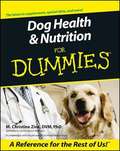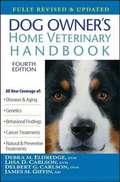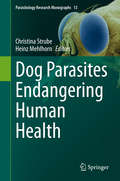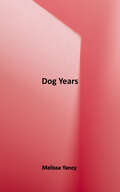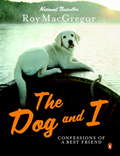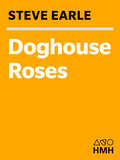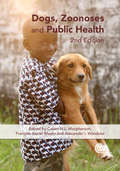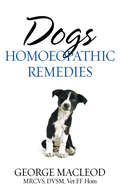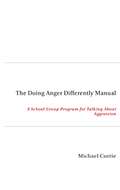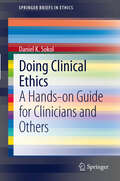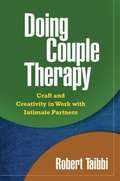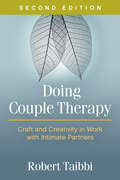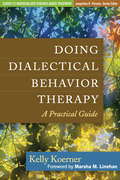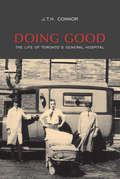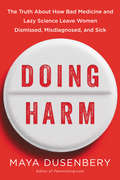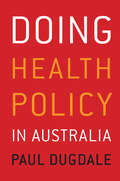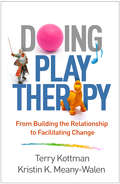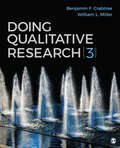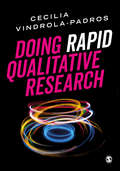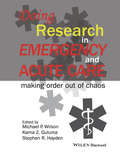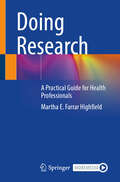- Table View
- List View
Dog Health and Nutrition for Dummies
by M. Christine ZinkHelp your dog enjoy a longer and healthier life with the latest in conventional and alternative veterinary medicine.
Dog Owner's Home Veterinary Handbook (4th Edition)
by Debra M. Eldredge Liisa D. Carlson Delbert G. Carlson James M. Giffin Beth AdelmanThis handbook, a hands-on reference, has been extensively revised to include the latest information on everything from canine healthcare to nutrition to holistic treatments. Dog Owner's Home Veterinary Handbook, Fourth Edition, is the definitive guide for every dog owner.
Dog Parasites Endangering Human Health (Parasitology Research Monographs #13)
by Heinz Mehlhorn Christina StrubeThis book presents the latest information on canine parasites with zoonotic potential, to help avoid human infections. Compiled by international specialists, it covers protozoa, ectoparasites and helminth species of clinical importance in dogs, as well as the state of the art in diagnosis, preventive measures and potentially necessary treatment schemes. Dogs are commonly kept in families around the world and can predispose their human companions to disease. Updating and deepening insights from other specialist literature, the book is intended for practitioners and scientists alike. It also offers practical guidance for veterinary and human physicians and highlights unexplored research areas, making it a valuable resource for students and educated non-experts with an interest in parasitology, infectiology and zoonotic pet diseases.
Dog Years (Drue Heinz Literature Prize)
by Melissa YancyMany of these richly layered stories juxtapose the miracles of modern medicine against the inescapable frustrations of everyday life: awkward first dates, the indignities of air travel, and overwhelming megastore cereal aisles. In “Go Forth,” an aging couple attends a kidney transplant reunion, where donors and recipients collide with unexpected results; in “Hounds,” a woman who runs a facial reconstruction program for veterans nurses her dying dog while recounting the ways she has used sex as both a weapon and a salve; and in “Consider This Case,” a lonely fetal surgeon caring for his aesthete father must reconsider sexuality and the lengths people will go to have children. <p><p>Melissa Yancy’s personal experience in the milieus of hospitals, medicine, and family services infuse her narratives with a rare texture and gravity. Keenly observant, offering both sharp humor and humanity, these stories explore the ties that bind—both genetic and otherwise—and the fine line between the mundane and the maudlin. Whether the men or women that populate these pages are contending with illness, death, or parenthood, the real focus is on time and our inability to slow its progression, reminding us to revel in those moments we can control.
Dog and I
by Roy MacgregorFrom Canada's beloved award-winning journalist and bestselling author comes a collection of essays, new and previously published, on man's best friend. In the course of 20 years of column writing about everything from politics to hockey and everything in between, Roy MacGregor has learned firsthand that the columns with the greatest reader impact have been those about the family dog. Roy has collected these columns and written many more on everything from puppy love to the sorrow of losing a pet, as experienced by Roy and the dogs he's known and loved.
Doghouse Roses: Stories
by Steve EarleSteve Earle does everything he does with intelligence, creativity, passion, and integrity. In music, these strengths have earned him comparisons to Bruce Springsteen, the ardent devotion of his fans, and the admiration of the media. And Earle does a lot: he is singer, songwriter, producer, social activist, teacher. . . . He&’s not only someone who makes great music; he&’s someone to believe in. With the publication of his first collection of short stories, Doghouse Roses, he gives us yet another reason to believe. Earle&’s stories reflect the many facets of the man and the hard-fought struggles, the defeats, and the eventual triumphs he has experienced during a career spanning three decades. In the title story he offers us a gut-wrenchingly honest portrait of a nearly famous singer whose life and soul have been all but devoured by drugs. &“Billy the Kid&” is a fable about everything that will never happen in Nashville, and &“Wheeler County&” tells a romantic, sweet-tempered tale about a hitchhiker stranded for years in a small Texas town. A story about the husband of a murder victim witnessing an execution addresses a subject Earle has passionately taken on as a social activist, and a cycle of stories features &“the American,&” a shady international wanderer, Vietnam vet, and sometime drug smuggler — a character who can be seen as Earle&’s alter ego, the person he might have become if he had been drafted. Earle is a songwriter&’s songwriter, and here he takes his writing gift into another medium, along with all the grace, poetry, and deep feeling that has made his music honored around the world.
Dogs, Zoonoses and Public Health
by John Bingham Jonathan Artz Thomas Daniels Karen Snowden Tiny Keuster Paul Torgerson Alexander Wandeler Calum Macpherson Christine Budke Bruno Chomel Ray Butcher Richard Halliwell Elly Hiby Eric Morgan Alan Beck François-Xavier Meslin Albis Francesco Gabrielli Robert Robinson Dennis C TurnerZoonotic diseases constitute a public health problem throughout the world. Addressing a little-studied area of veterinary and medical science, this book covers viral, bacterial, protozoan and helminth parasites transmitted between humans and dogs, discussing population management, control disease agents and human-dog relationships. Fully updated throughout, this new edition also includes chapters on benefits of the human-dog relationship and non-infectious disease issues with dogs. It is a valuable resource for researchers and students of veterinary and human medicine, microbiology, parasitology and public health.
Dogs: Homoeopathic Remedies
by George MacleodThis book is written to satisfy the needs of the increasing numbers of dog lovers who are interested in alternative methods to treat their pets. This comprehensive guide introduces the principles of homoeopathy and the nature of homoeopathic remedies, explaining how remedies can be prepared and administered. There are informative sections on treating the different canine bodily systems and the specific diseases that dogs may suffer from. There is also helpful advice on canine virus and bacterial diseases, as well as the diseases of puppyhood, making this book a must for any dog owner.
Doing Anger Differently Manual: A School Group Program for Talking About Aggression
by Michael CurrieYoung, non-verbal and aggressive adolescent boys often feel constricted within their family environment, swinging between explosive outbursts and sullen monosyllabic exchanges. Such exchanges are the disturbing expression of a problem that parents often feel they can do little about, except reply in kind. The manner in which an adolescent understands and misunderstands events has a causative role in the problem of aggression. Michael Currie presents here a new approach that allows parents and others to take a key role in shaping this (mis)understanding of adolescent children. Doing Anger Differently presents complex theoretical issues from the existing adolescent and aggression treatment literature in a set of clear and practical principles, which are illustrated with case studies taken from the author's years of experience working with angry boys. Parents, teachers or anyone who has contact with adolescents can adapt these principles to help them deal with aggressive boys.
Doing Clinical Ethics
by Daniel K. SokolIn this Brief, Daniel Sokol interprets 'doing medical ethics' broadly to capture the application of ethical knowledge to a concrete situation, rather than just resolving a moral dilemma contained within a case. It instructs clinicians on how to identify and analyse a clinical ethics case, and guides the reader in publishing in general medical, specialist medical, and medical ethics journals, and through presenting on ethical issues at conferences. In addition to this, advice on how to teach medical ethics, and apply for research ethics approval, is included. "...an admirably short and clear guide to doing medical ethics... I welcome this book and urge medical students and doctors of all grades to read it in paper, on-line or on your portable screen reader." Sir Richard Thompson, President of the Royal College of Physicians, UK "Dr. Sokol has provided the field with a much needed, easy and comprehensive tool on 'doing' clinical ethics that all should have in their back pockets." Dr. Nneka Mokwunye, Director of Bioethics, Washington Hospital Center, Washington DC, USA "This is a magnificent guide to clinical ethics and reflects the author's very well known and widely respected academic gravitas and real life experience in clinical ethics. It is a "must read" for anyone involved in the field." Mr. Vassilios Papalois, Consultant Surgeon and Chairman, Imperial College Healthcare NHS Trust Clinical Ethics Committee, UK
Doing Couple Therapy
by Robert Taibbi Richard SchwartzWise, compassionate, and highly practical, this engaging text covers the entire process of therapeutic work with couples, from opening sessions and assessment through skills building, core issues, and termination. Students and novice couple therapists learn effective strategies for intervening with couples of any age who are struggling with acute crises or longstanding conflicts and power struggles. Rich with sensitive, detailed case material, the book features numerous exercises that help readers identify and develop their own strengths as practitioners. Self-care strategies and tips for getting the most out of supervision are provided. Special topics include how to address couple issues with only one partner and couple therapy applications for chronic mental health problems.
Doing Couple Therapy, Second Edition: Craft and Creativity in Work with Intimate Partners
by Robert TaibbiNow thoroughly revised, this practical, user-friendly guide has helped thousands of novice couple therapists and students to navigate the challenges of clinical work with couples in conflict. Robert Taibbi presents effective strategies for rapidly identifying a couple's core issues and conducting each stage of therapy, from the first sessions to termination. Rich with sensitive case material, the book features end-of-chapter exercises that help readers identify and develop their own strengths as practitioners. Appendices include reproducible client handouts that can be downloaded and printed in a convenient 8 1/2" x 11" size. New to This Edition *Three chapters offering detailed treatment maps for common couple problems, with new case examples. *Chapter on the middle stages of treatment. *Increased attention to the all-important opening sessions. *Sharper focus on the three major obstacles to couple success: poor communication, emotional wounds, and differing visions. *Reproducible client handouts explaining key techniques. See also the author's Doing Family Therapy, Third Edition: Craft and Creativity in Clinical Practice.
Doing Dialectical Behavior Therapy
by Kelly KoernerFilled with vivid clinical vignettes and step-by-step descriptions, this book demonstrates the nuts and bolts of dialectical behavior therapy (DBT). DBT is expressly designed for and shown to be effective with clients with serious, multiple problems and a history of treatment failure. The book provides an accessible introduction to DBT while enabling therapists of any orientation to integrate elements of this evidence-based approach into their work with emotionally dysregulated clients. Experienced DBT clinician and trainer Kelly Koerner clearly explains how to formulate individual cases; prioritize treatment goals; and implement a skillfully orchestrated blend of behavioral change strategies, validation strategies, and dialectical strategies.
Doing Dialectical Behavior Therapy
by Marsha M. Linehan Kelly KoernerFilled with vivid clinical vignettes and step-by-step descriptions, this book demonstrates the nuts and bolts of dialectical behavior therapy (DBT). DBT is expressly designed for--and shown to be effective with--clients with serious, multiple problems and a history of treatment failure. The book provides an accessible introduction to DBT while enabling therapists of any orientation to integrate elements of this evidence-based approach into their work with emotionally dysregulated clients. Experienced DBT clinician and trainer Kelly Koerner clearly explains how to formulate individual cases; prioritize treatment goals; and implement a skillfully orchestrated blend of behavioral change strategies, validation strategies, and dialectical strategies. See also Dialectical Behavior Therapy in Clinical Practice: Applications across Disorders and Settings, edited by Linda A. Dimeff and Kelly Koerner, which presents exemplary DBT programs for specific clinical problems and populations.
Doing Good
by J.T.H. ConnorA history of Toronto's general hospital offers a window on a broader history of Upper Canada and Ontario over the last two centuries. In this lively and authoritative account, J.T.H. Connor traces the hospital's two-hundred-year evolution, as its mandate to 'do good' forced constant adjustment to changing social, medical, and government attitudes.Doing Good presents the hospital's history in three phases - roughly speaking, the first and second halves of the nineteenth century, and the twentieth century. From its conception in 1797 to the mid-1850s - it did not actually acquire a home until 1819 nor occupy it until 1829 - it functioned as a charitable institution, catering to the sick poor. It acted initially as a clearing station for sick immigrants; it later was deeply affected by political events and became embroiled in the medical turmoil of Toronto in the 1840s and early 1850s. In the second era, from the mid-1850s, it was a public charity, receiving stable government funding and constructing a new home in eastern Toronto. By the 1870s, it was winning praise as a model hospital.In the twentieth century, it early on established close links with the University of Toronto, building a vast and up-to-date new facility adjacent to the university, which opened in 1913. Its international reputation as an academic hospital grew over the decades to include a high profile in research, most notably in cancer and medical technology. By the 1960s the institution was being run as a public hospital, and the late 1990s saw its absorption into a hospital mega-corporation - the University Health Network - along with three other nearby hospitals.This work is the most comprehensive analysis of any Canadian hospital or health care institution yet to appear. Using trustees' minutes, medical journals, newspapers, and government reports, along with correspondence, photographs, and reminiscences of trustees, nurses, doctors, and patients, Connor offers acute observation and detailed analysis, as well as compelling character studies and revealing anecdotes. Broad in scope and meticulously executed, Doing Good brings vividly to life the day-to-day routines, the behind-the-scenes intrigue, and the people and politics of a great urban hospital.
Doing Harm: The Truth About How Bad Medicine and Lazy Science Leave Women Dismissed, Misdiagnosed, and Sick
by Maya DusenberyEditor of the award-winning site Feministing.com, Maya Dusenbery brings together scientific and sociological research, interviews with doctors and researchers, and personal stories from women across the country to provide the first comprehensive, accessible look at how sexism in medicine harms women today. <p><p> In Doing Harm, Dusenbery explores the deep, systemic problems that underlie women’s experiences of feeling dismissed by the medical system. Women have been discharged from the emergency room mid-heart attack with a prescription for anti-anxiety meds, while others with autoimmune diseases have been labeled “chronic complainers” for years before being properly diagnosed. Women with endometriosis have been told they are just overreacting to “normal” menstrual cramps, while still others have “contested” illnesses like chronic fatigue syndrome and fibromyalgia that, dogged by psychosomatic suspicions, have yet to be fully accepted as “real” diseases by the whole of the profession. <p> An eye-opening read for patients and health care providers alike, Doing Harm shows how women suffer because the medical community knows relatively less about their diseases and bodies and too often doesn’t trust their reports of their symptoms. The research community has neglected conditions that disproportionately affect women and paid little attention to biological differences between the sexes in everything from drug metabolism to the disease factors—even the symptoms of a heart attack. Meanwhile, a long history of viewing women as especially prone to “hysteria” reverberates to the present day, leaving women battling against a stereotype that they’re hypochondriacs whose ailments are likely to be “all in their heads.” <p> Offering a clear-eyed explanation of the root causes of this insidious and entrenched bias and laying out its sometimes catastrophic consequences, Doing Harm is a rallying wake-up call that will change the way we look at health care for women.
Doing Health Policy in Australia
by Paul DugdalePaul Dugdale argues that Australia's health policy scene is in rude health, with regular debates about major reform and a steady stream of minor reforms. What motivates these debates and reforms? How can nine governments, and scores of professional associations, charities and businesses interact effectively without a master plan? Why are some health policy changes met with widespread enthusiasm and others enormous resistance?Dugdale traces the history of the economic and social forces which have shaped Australia's health system. He examines the thinking of government as it is expressed through contemporary health policy, and the roles of the key players including hospitals, the medical profession and health departments. He also discusses major current concerns including Indigenous health, health finance, the medical labour market, health protection and safety issues.With its insider's perspective on the health system and policy debates, Doing Health Policy in Australia is essential reading for health professionals working in management and policy roles.Paul Dugdale's account of health policy in Australia is engaging, philosophical, reflective and socially informed. - Professor Stephen Leeder, University of SydneyA distinctive addition to the pantheon of Australian books on health policy, weaving together social theory, history and philosophy with reflective commentaries on the Australian health system and health policy, and on being an activist within the policy-making world. It challenges convention and standard expectations. - Professor Vivian Lin, La Trobe University
Doing Play Therapy: From Building the Relationship to Facilitating Change (Creative Arts and Play Therapy)
by Terry Kottman Kristin K. Meany-WalenCovering the process of therapy from beginning to end, this engaging text helps students and practitioners use play confidently and effectively with children, adolescents, and adults struggling with emotional or behavioral problems or life challenges. With an accessible theory-to-practice focus, the book explains the basics of different play therapy approaches and invites readers to reflect on and develop their own clinical style. It is filled with rich case material and specific examples of play techniques and strategies. The expert authors provide steps for building strong relationships with clients; exploring their clinical issues and underlying dynamics; developing and working toward clear treatment goals; and collaborating with parents and teachers. A chapter on common challenges offers insightful guidance for navigating difficult situations in the playroom.
Doing Qualitative Research
by William L. Miller Benjamin F. CrabtreeThe long-awaited third edition of Doing Qualitative Research by Benjamin F. Crabtree and William L. Miller is out! Co-create your own inspired research stories with this reader-friendly text on qualitative methods, design, and analysis. Written for both students and researchers with little to no qualitative experience, as well as investigators looking to expand and refine their expertise, this clear and concise book will quickly get readers up to speed doing truly excellent qualitative research. The first four chapters of the book set the stage by contextualizing qualitative research within the overall traditions of research, focusing on the history of qualitative research, the importance of collaboration, reflexivity, and finding the appropriate method for your research question. Each part then addresses a different stage of the research process, from data collection, data analysis and interpretation, and refocusing on the bigger picture once your research is complete. Unique chapters cover case study research, intervention studies, and participatory research. The authors use their experiences and knowledge to provide both personal and published research stories to contextualize qualitative concepts. Many of the examples demonstrate the use of qualitative methods within a mixed-methods approach. Each chapter concludes with open-ended questions to further reader contemplation and to spark discussions with classmates and colleagues. With an abundance of clinical research examples featuring a variety of qualitative methods, Doing Qualitative Research encourages researchers to learn by doing and actively experiment with the tools and concepts presented throughout the book.
Doing Qualitative Research
by William L. Miller Benjamin F. CrabtreeThe long-awaited third edition of Doing Qualitative Research by Benjamin F. Crabtree and William L. Miller is out! Co-create your own inspired research stories with this reader-friendly text on qualitative methods, design, and analysis. Written for both students and researchers with little to no qualitative experience, as well as investigators looking to expand and refine their expertise, this clear and concise book will quickly get readers up to speed doing truly excellent qualitative research. The first four chapters of the book set the stage by contextualizing qualitative research within the overall traditions of research, focusing on the history of qualitative research, the importance of collaboration, reflexivity, and finding the appropriate method for your research question. Each part then addresses a different stage of the research process, from data collection, data analysis and interpretation, and refocusing on the bigger picture once your research is complete. Unique chapters cover case study research, intervention studies, and participatory research. The authors use their experiences and knowledge to provide both personal and published research stories to contextualize qualitative concepts. Many of the examples demonstrate the use of qualitative methods within a mixed-methods approach. Each chapter concludes with open-ended questions to further reader contemplation and to spark discussions with classmates and colleagues. With an abundance of clinical research examples featuring a variety of qualitative methods, Doing Qualitative Research encourages researchers to learn by doing and actively experiment with the tools and concepts presented throughout the book.
Doing Rapid Qualitative Research
by Cecilia Vindrola-PadrosIf you are working in a time-sensitive context, need to deliver research findings so they can be used to inform decisions, or are finding it difficult to access research funding for long-term qualitative research, this book will help you. Introducing ‘rapid qualitative research’, it demonstrates how you can conduct high quality qualitative research within time, access and resource constraints. The book uses real world examples to illustrate the benefits and challenges of using rapid qualitative research designs. Focusing on the when, why and how, it explains the difference between cutting corners and making quick, well-informed research choices that support rigorous, credible research. Key features of the book include discussion questions and exercises for you to reflect on and apply your learning, as well as two case study chapters of real-world research so you can see rapid research in action. Written by the world’s leading expert on this subject, this book contains the theoretical and practical nuts and bolts you need to reframe existing qualitative methods, speed up your research, and make tangible contributions to your field. It is the perfect companion for any researcher, final-year undergraduate or postgraduate student looking to conduct rapid, but rigorous, qualitative research.
Doing Rapid Qualitative Research
by Cecilia Vindrola-PadrosIf you are working in a time-sensitive context, need to deliver research findings so they can be used to inform decisions, or are finding it difficult to access research funding for long-term qualitative research, this book will help you. Introducing ‘rapid qualitative research’, it demonstrates how you can conduct high quality qualitative research within time, access and resource constraints. The book uses real world examples to illustrate the benefits and challenges of using rapid qualitative research designs. Focusing on the when, why and how, it explains the difference between cutting corners and making quick, well-informed research choices that support rigorous, credible research. Key features of the book include discussion questions and exercises for you to reflect on and apply your learning, as well as two case study chapters of real-world research so you can see rapid research in action. Written by the world’s leading expert on this subject, this book contains the theoretical and practical nuts and bolts you need to reframe existing qualitative methods, speed up your research, and make tangible contributions to your field. It is the perfect companion for any researcher, final-year undergraduate or postgraduate student looking to conduct rapid, but rigorous, qualitative research.
Doing Research in Emergency and Acute Care: Making Order Out of Chaos
by Kama Z. Guluma Michael P. Wilson Stephen R. HaydenA practical guide to understanding and navigating the unique challenges faced by physicians and other professionals who wish to undertake research in the ED or other acute care setting. Focusing on the hyper-acute and acute care environment and fulfilling two closely-related needs: 1) the need for even seasoned researchers to understand the specific logistics and issues of doing research in the ED; and 2) the need to educate clinically active physicians in research methodology. This new text is not designed to be a complex, encyclopedic resource, but instead a concise, easy-to-read resource designed to convey key "need-to-know" information within a comprehensive framework. Aimed at the busy brain, either as a sit-down read or as a selectively-read reference guide to fill in knowledge gaps, chapters are short, compartmentalized, and are used strategically throughout the text in order to introduce and frame concepts. This format makes it easy - and even entertaining - for the research novice to integrate and absorb completely new (and typically dry) material. The textbook addresses aspects of feasibility, efficiency, ethics, statistics, safety, logistics, and collaboration in acute research. Overall, it grants access for the seasoned researcher seeking to learn about acute research to empathically integrate learning points into his or her knowledge base. As the ED is the primary setting for hyper-acute and acute care, and therefore a prime site for related clinical trial recruitment and interventions, the book presents specific logistical research challenges that researchers from any discipline, including physicians, research nurse coordinators, study monitors, or industry partners, need to understand in order to succeed.
Doing Research: A Practical Guide for Health Professionals
by Martha E. HighfieldThis book provides a step-by-step summary of how to do clinical research. It explains what research is and isn’t, where to begin and end, and the meaning of key terms. A project planning worksheet is included and can be used as readers work their way through the book in developing a research protocol. The purpose of this book is to empower curious clinicians who want data-based answers. Doing Research is a concise, user-friendly guide to conducting research, rather than a comprehensive research text. The book contains 12 main chapters followed by the protocol worksheet. Chapter 1 offers a dozen tips to get started, Chapter 2 defines research, and Chapters 3-9 focus on planning. Chapters 10-12 then guide readers through challenges of conducting a study, getting answers from the data, and disseminating results. Useful key points, tips, and alerts are strewn throughout the book to advise and encourage readers.
Doing Things: A Guide to Programing Activities for Persons with Alzheimer's Disease and Related Disorders
by Jitka M. ZgolaDoing Things shows how to provide a positive environment for persons with Alzheimer's disease by offering opportunities for social interaction and constructive, enjoyable activities. Zgola outlines the ways in which a patient's functional impairment can be assessed; the strengths, weaknesses, and needs most commonly encountered among persons with Alzheimer's disease; and ways activities can be tailored to accommodate them. She offers step-by-step instructions for selecting and presenting appropriate activities and includes cooking and crafts projects, a sample exercise routine, and a sample daily schedule. The techniques she describes are designed to promote a sense of security and self-esteem, by avoiding possible sources of confusion or confrontation.Based on the highly successful program developed at one day-care facility for persons with dementia, Doing Things offers an invaluable guide for professionals and volunteers supervising activities at day-care centers and extended-care facilities—as well as for individuals who are caring for patients at home. Throughout, Zgola's emphasis is on treating persons who have Alzheimer's disease with empathy, courtesy, and dignity.
